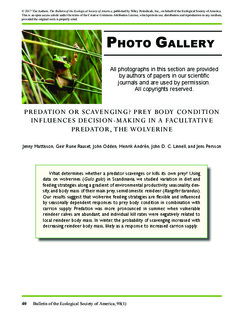Predation or scavenging? Prey body condition influences decision-making in a facultative predator, the wolverine. Photo gallery
Mattisson, Jenny; Rauset, Geir Rune; Odden, John; Andrén, Henrik; Linnell, John Durrus; Persson, Jens
Journal article, Peer reviewed

Åpne
Permanent lenke
http://hdl.handle.net/11250/2443121Utgivelsesdato
2017Metadata
Vis full innførselSamlinger
- Publikasjoner fra CRIStin - NINA [2364]
- Scientific publications [1392]
Originalversjon
The Bulletin of the Ecological Society of America. 2017, 98 (1), 40-46.Sammendrag
What determines whether a predator scavenges or kills its own prey? Using data on wolverines ( Gulo gulo ) in Scandinavia, we studied variation in diet and feeding strategies along a gradient of environmental productivity, seasonality, density, and body mass of their main prey, semidomestic reindeer ( Rangifer tarandus ). Our results suggest that wolverine feeding strategies are flexible and influenced by seasonally dependent responses to prey body condition in combination with carrion supply. Predation was more pronounced in summer, when vulnerable reindeer calves are abundant, and individual kill rates were negatively related to local reindeer body mass. In winter, the probability of scavenging increased with decreasing reindeer body mass, likely as a response to increased carrion supply.
